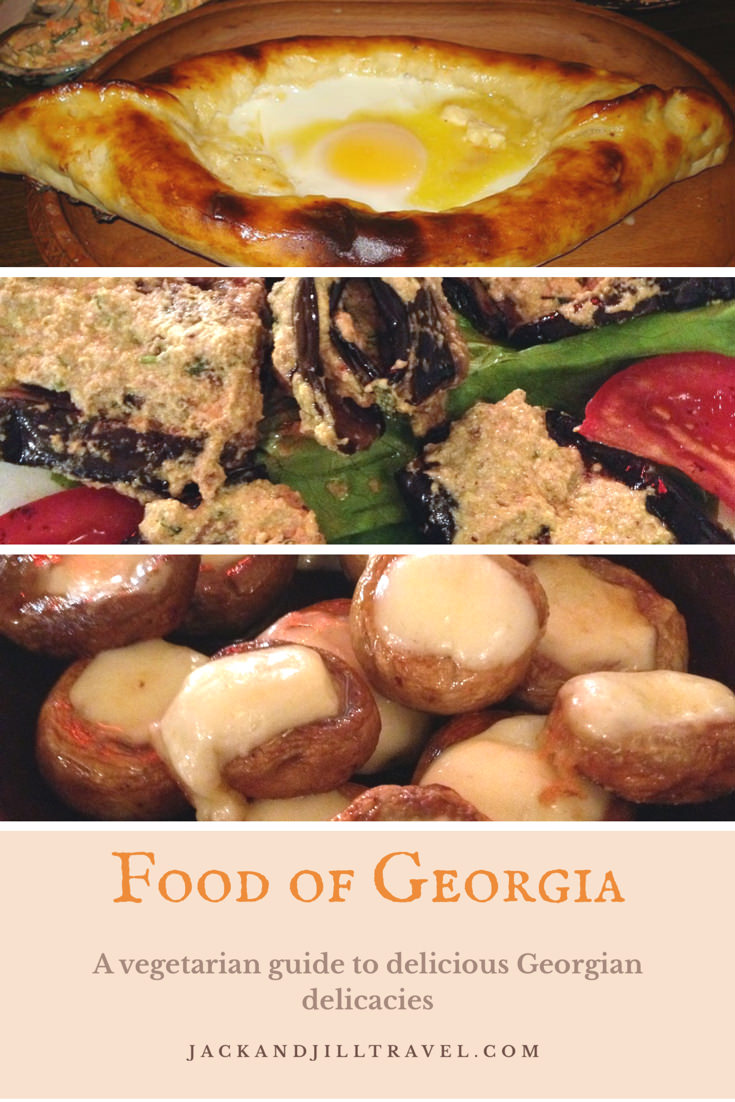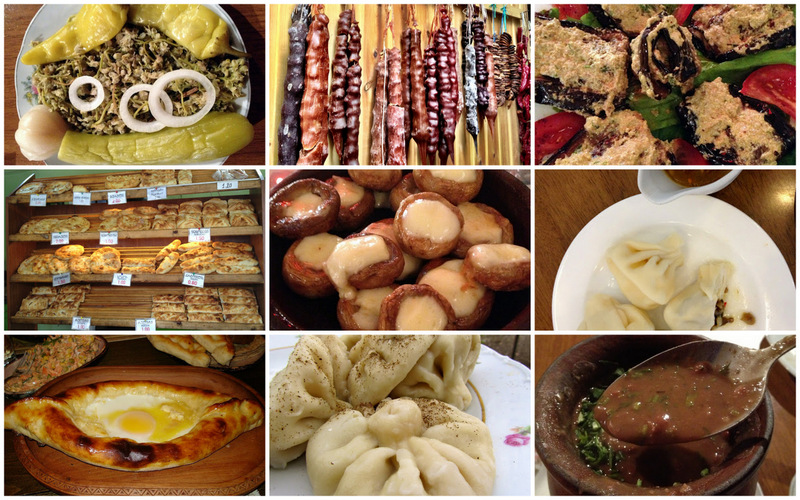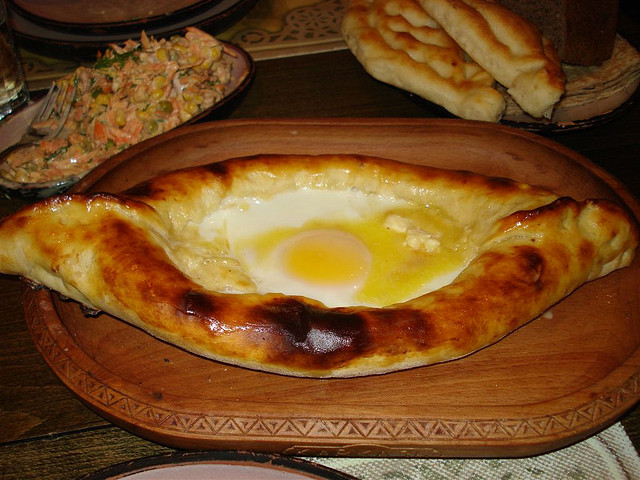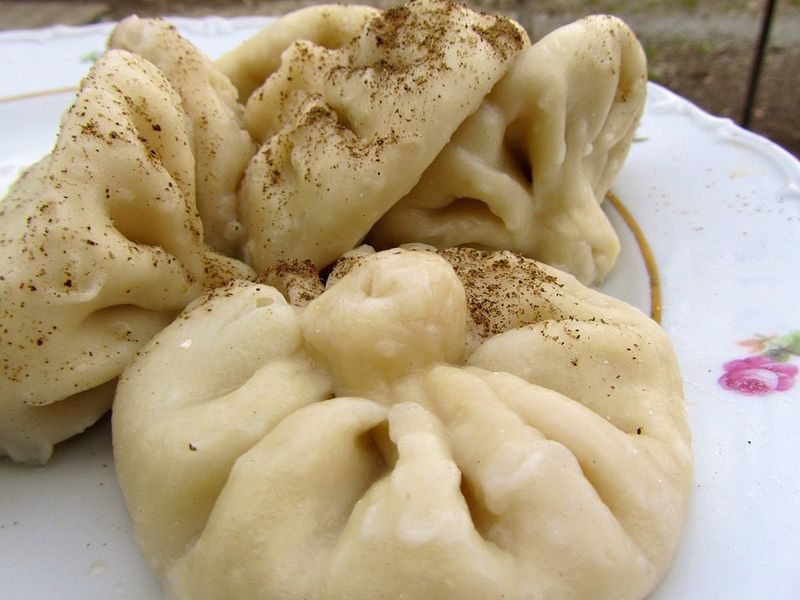Georgia
As a vegetarian I wasn’t sure how I would be able to find vegetarian friendly food in Georgia. This part of the world stereotypically consumes quite a lot of meat. But man, was I in for a surprise… I enjoyed Georgian food so much more than Turkish food (which I also love). I definitely didn’t expect that.

Is Georgia vegetarian friendly?
It turned out that Georgian food is a lot more vegetarian friendly than Turkish food. Georgians do incredible stuff with walnut, eggplant, mushroom and cheese. The latter 3 items being my all around favorite things in the world to eat so I guess it’s no surprise as a vegetarian, I found Georgian food very much agreeable.
In Georgia, they have this walnut paste thingy that was pretty close to the most incredible thing I’ve ever tasted. It’s like cheese, but lighter, nuttier… Sigh. I have to find it here in the States.
But if you’re a cheese lover, you’ll like it here too. In fact, it’ll be hard to NOT eat cheese in Georgia.
Once you see the list of vegetarian Georgian foods I’ve made below, I think you’ll be surprised (or maybe not – I don’t know) how vegetarian friendly Georgia is.

Khachapuri
Think of pizza on steroids and what you get is khachapuri. Several regions in Georgia have their own versions of khachapuri but all involve lots of cheese. Some can seem overly cheesy (is there such a thing?)
Megruli Khachapuri for example is cheese filled pie topped with more cheese. However I thought the most over the top khachapuri award has to go to Adjari Khachapuri: a bowl shaped bread filled with melted cheese and served with an egg on top and pats of butter.
 Adjrani khachapuri by grendelyn
Adjrani khachapuri by grendelyn
It’s the Caucasus version of heart attack on a plate.
Khachapuris and more in Tbilisi, Georgia
Regular khachapuris are a much more mellow version of this, consisting of simply cheese inside a round or square shaped dough. Sold practically all over the place, they make for perfect snacks on the go.
Khinkali

Khinkali by G. Opaz
Khinkali is another Georgian staple that you can not miss to try if you’re in Georgia. If you think they look like dumplings, you’re absolutely right. They’re Georgian dumplings. At 30-50 cents a piece they’re also the staples of budget travelers like me. Meat and mushroom are the most common type of fillings.
A lot of places serve vegetarian-friendly khinkalis, stuffed with cheese and vegetables. I had so many of these towards the end I couldn’t eat them anymore.
How to eat a khinkali:
You hold the ‘hat’ of the dumpling, bite a hole and suck the juice out of the filling. Then you eat it all at once except for ‘hat’ which is basically just a very thick dough. You leave this part on your plate. This is how one is supposed to keep track how many khinkalis they’ve had. I personally like mine with liberal sprinkling of black pepper.
Nigvziani badrijani
I have no idea how to pronounce the first word, but saying “badrijani” seems to work just fine. This is probably my favorite vegetarian dish in Republic of Georgia. It consists of thinly sliced eggplant, pan fried, and topped with that wonderful, spiced walnut paste I mentioned above which totally makes it! You can find badrijani in any traditional Georgian restaurants.
The first time I took a bite, I’m pretty sure I uttered a moan that’s not quite PG. I’m glad I was alone.
Lobio/Lobiani
Lobiani, or Georgian bean stew
We’re having a cold front right now in California and I’d kill for a pot of lobio. Served in a clay jar, lobio is rich and flavorful bean stew. So filling and so perfect for cold nights. It goes well with cheese and mchadi – a super dense cornbread that will sit like a brick in your stomach if you eat too much of it.
Baked mushroom with sulguni cheese
Baked mushroom with sulguni cheese
This dish consists of mushrooms filled with Sulguni cheese baked in buttery broth in traditional Georgian clay “ketsi” dishes. Sounds delish, right? If you’re a mushroom and cheese lover like me, you’d be chomping on these like popcorn.
Jonjoli
Everything there is pickled. Eeew.
When I first took a bite of jonjoli, I spat it back out. Second and third attempts fared no better. Jonjoli looked and tasted like it belonged in a compost pile (no offense to jonjoli lovers out there). The only reason I ordered it was because a Georgian I met on the bus wrote it down and highly recommended it to me.
So yeah, sometimes local advice just doesn’t work.
Someone at the restaurant came and indicated that I should try putting in my lobio. So I did. And it made it a lot more edible.
I later learned that jonjoli is actually pickled flowers of a shrub that grows localy in Georgia. This explains my reaction. I can NOT stand pickled anything.
So there you go, if you like pickles, you should give jonjoli a try and let me know what you think of it.
Churchkhela
Churchkela in Tbilisi, Georgia
Churchkela in Tbilisi, Georgia
Also known as ‘Georgian Snickers’ this sausage-shaped candy doesn’t look like much but they’re quite delicious. This grape jelly and nut snack is often sold at roadsides and made by dipping a string of nuts repeatedly in a vat containing flour, sugar and concentrated grape juice solution.
The price depends on the type of nut and the type of grapes used.
How to eat a churchkela:
Bite and hold a nut and pull it off the string.
The condiments
Georgian food is not very spicy. But they do offer a variety of condiments or sauces to complement your dishes. The most common is, tkemali a sour plum type of sauce. I didn’t care so much for it but a lot of people like it. Another common sauce is ajika or ‘adjika’ – a spicy, tomato-y sauce that I much prefer.
—
Can somebody please start a Georgian food truck here in San Francisco already?





Questions and Comments
Comments are disabled. If you have any questions about the post, you can DM me on Instagram: @jacknjilltravel.